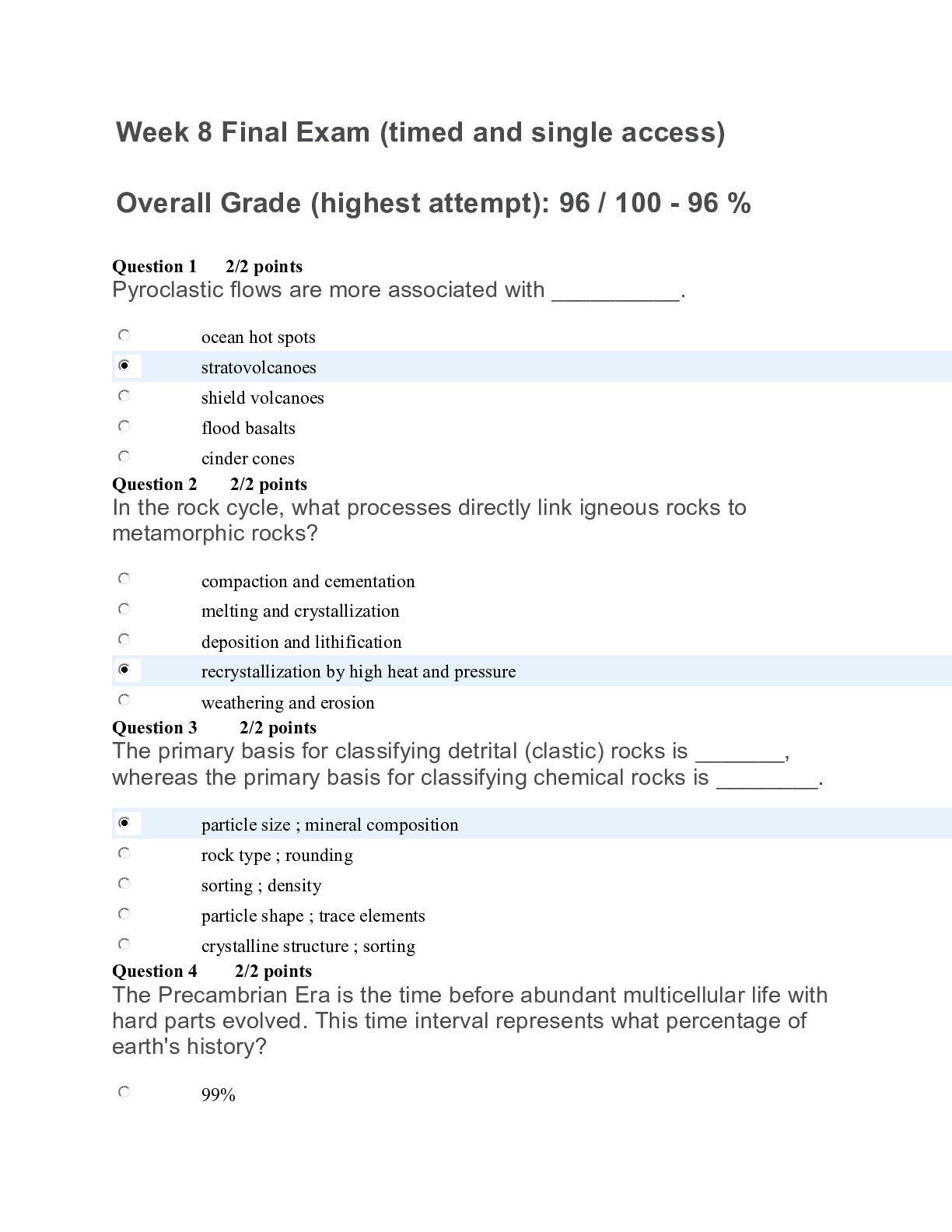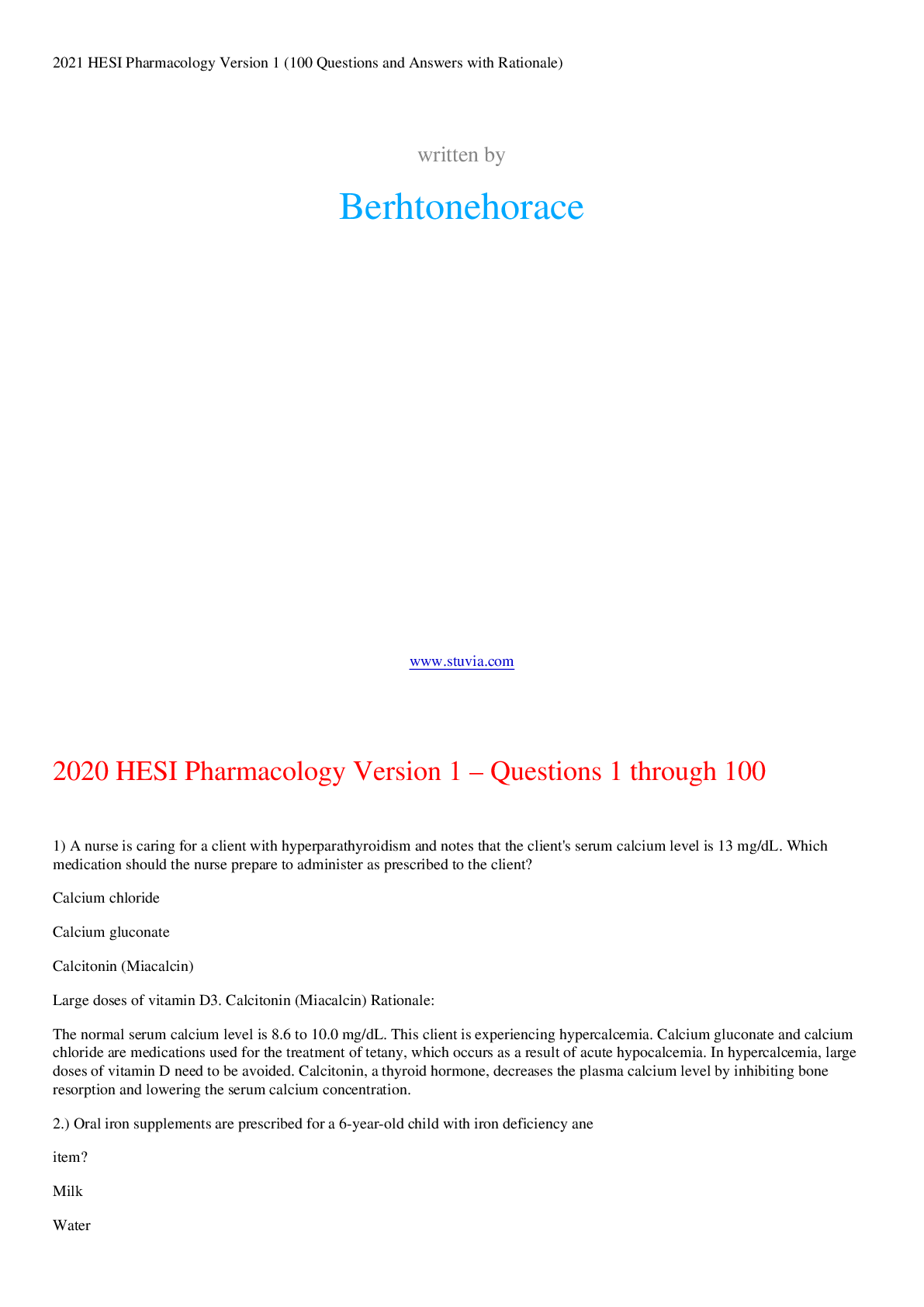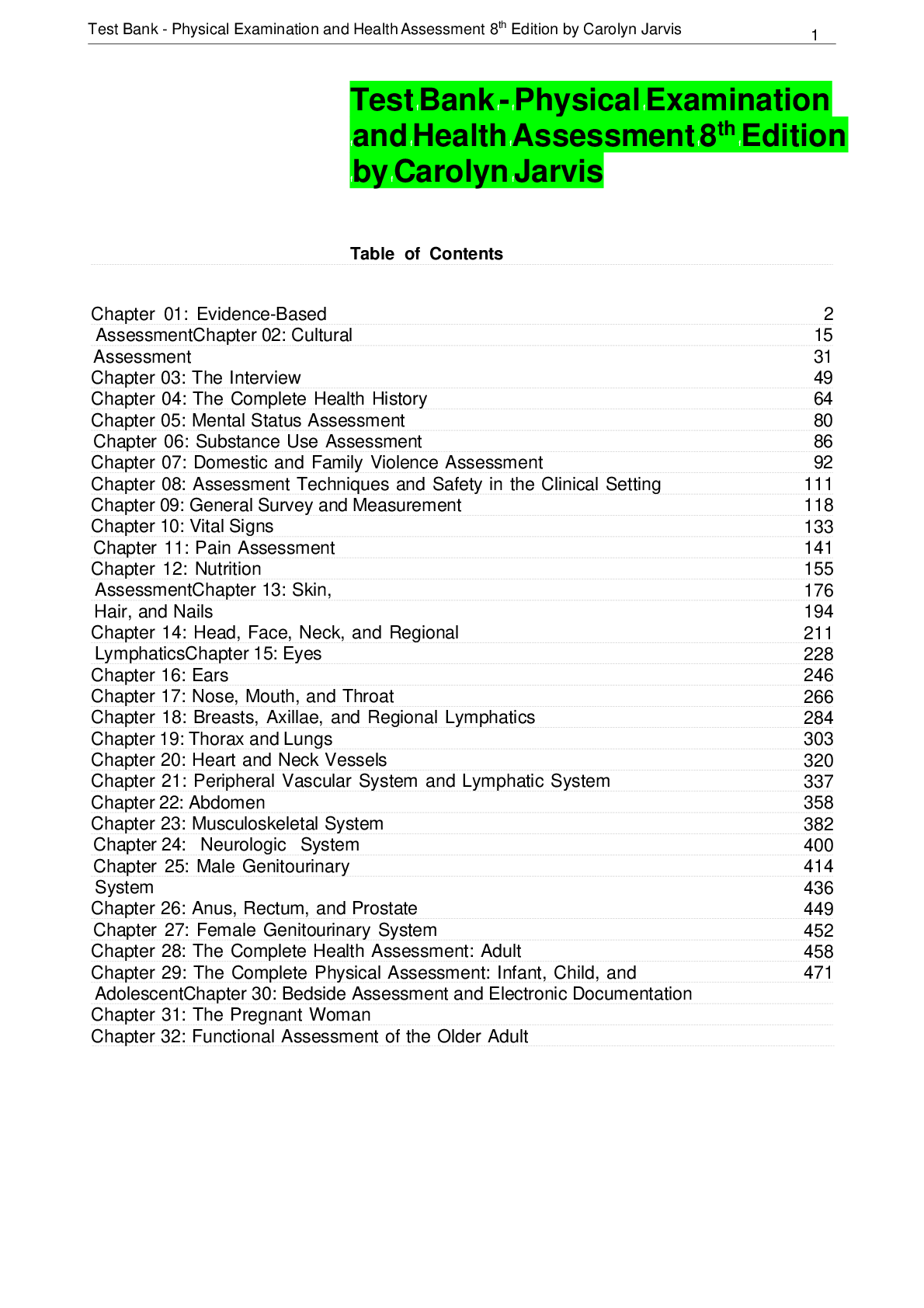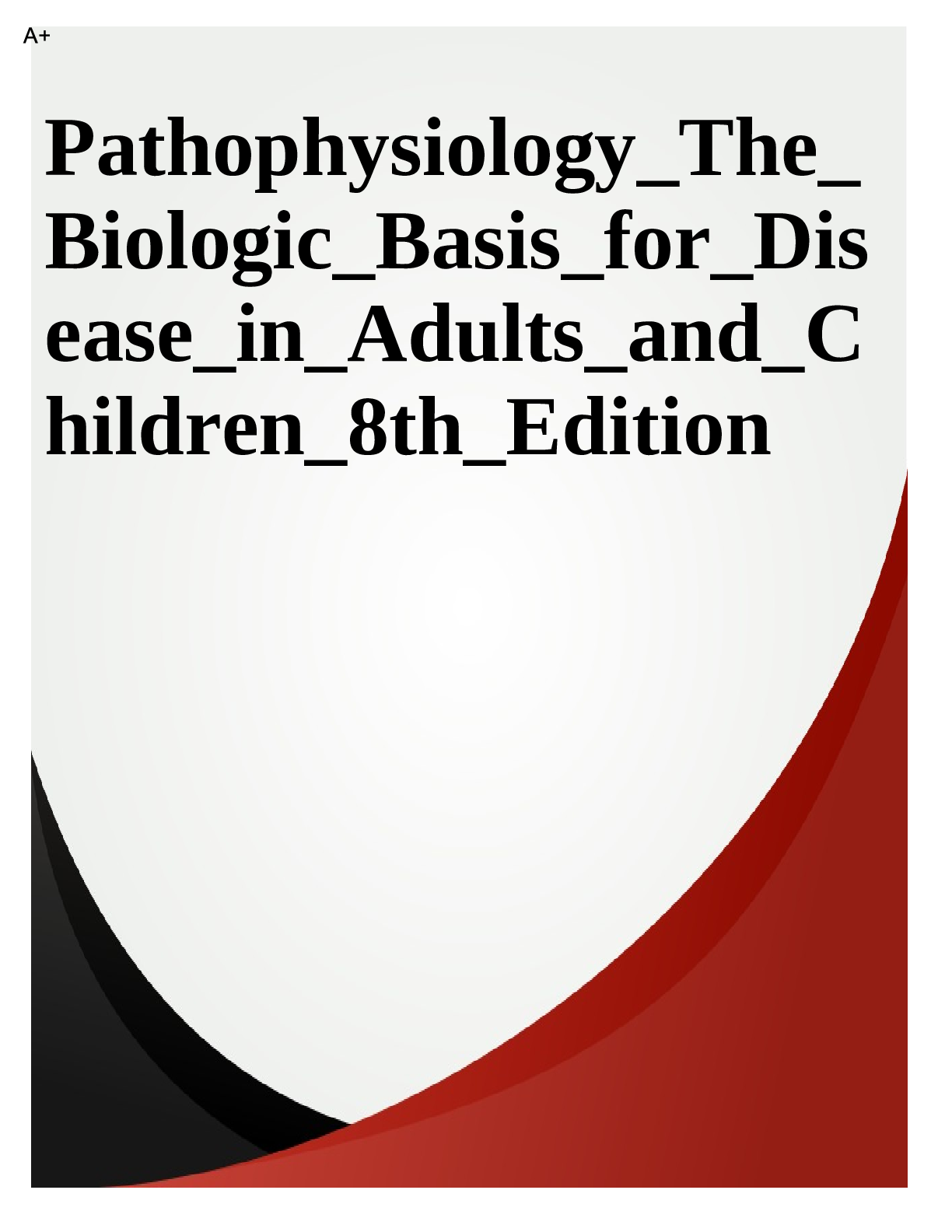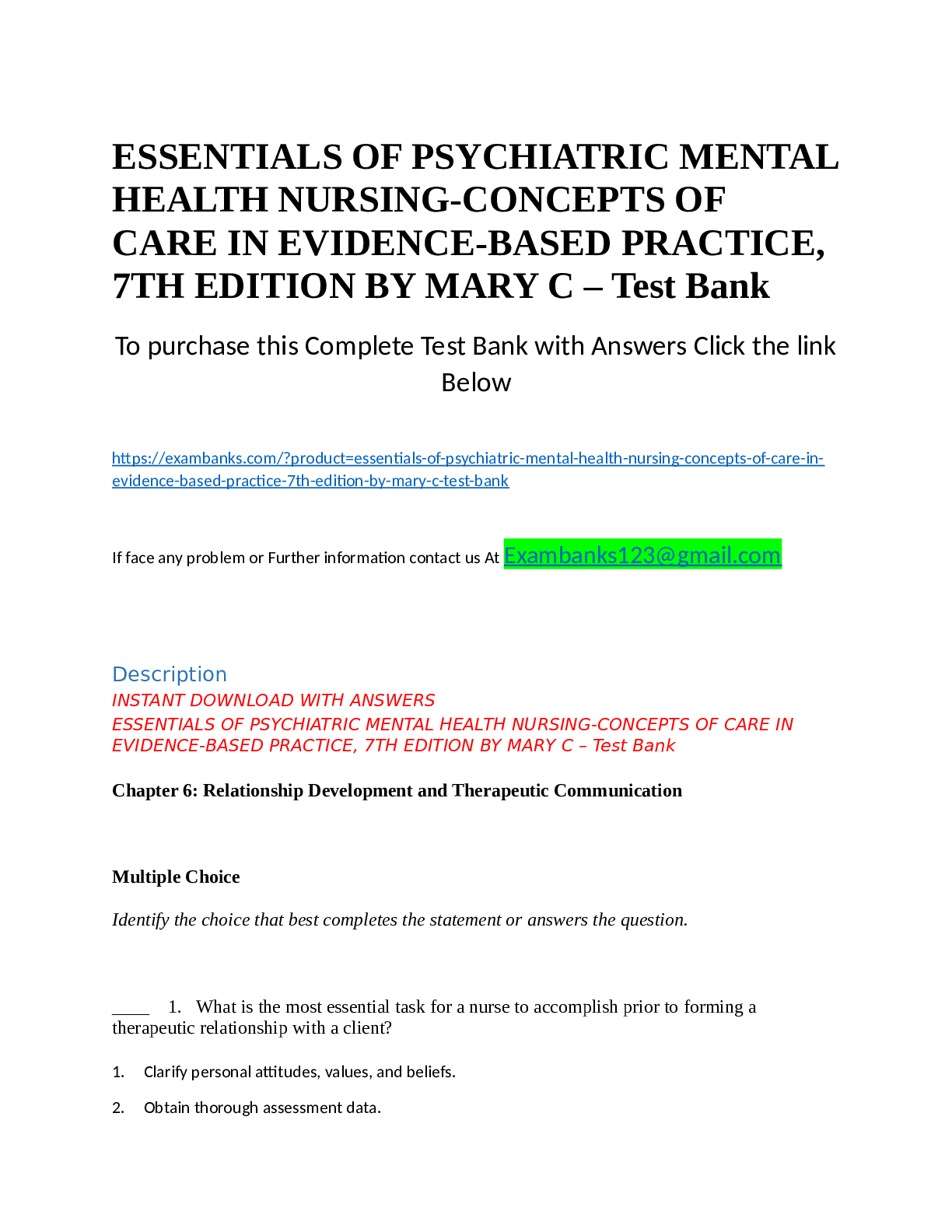EMERGENCY CARE IN THE STREETS 8TH EDITION BY NANCY CAROLINE TEST BANK
Document Content and Description Below
EMERGENCY CARE IN THE STREETS 8TH EDITION BY NANCY CAROLINE TEST BANK CHAPTER 1 1. EMS stands for: a. Evolve Medical Service b. Emergency Medical Services c. Emergency Medical School d. ... European Medical Services ANS: B DIF: Easy REF: Pg. 4 2. The first recorded use of an ambulance was by the military during the Siege of Malaga in: a. At the beginning of 1400 b. In the mid of 1400 c. At the start of 1500 d. At the end of 1400 ANS: D DIF: Moderate REF: pg. 4 3. (CoAEMSP) is the only accrediting body for paramedic programs which stands for: a. Committee on Accreditation of Educational Programs for the EMS Professions b. Committee on Association of Educational Programs for the EMS Professions c. Conference on Accreditation of Educational Programs for the EMS Professions d. Committee on Accreditation of Educational Programs for the EMS People ANS: A DIF: Hard REF: Pg. 10 4. A registry system which is used to test and establish licensure is: a. NREMT b. NREMS c. NREMP d. NREMR ANS: A DIF: Moderate REF: Pg. 9 5. What is Reciprocity? a. Granting certification to a provider from same state or agency b. Granting certification to a provider from another state or agency c. Granting certification to a provider both from same or another state d. No need of granting certification from any state ANS: B DIF: Easy REF: Pg. 10 6. Select the correct ranking: a. The Dispatcher, EMT, Paramedic, Advanced EMT, Emergency Medical Responder b. Emergency Medical Responder, Paramedic, EMT, Advanced EMT, The Dispatcher c. Paramedic, Advanced EMT, EMT, Emergency Medical Responder, The Dispatcher d. The Dispatcher, Emergency Medical Responder, EMT, Advanced EMT, Paramedic ANS: D DIF: Moderate REF: Pg. 12, 13 7. Who launched the first rescue squad called Roanoke Life Saving in 1928? a. Nancy Lee Caroline b. Baron Dominique-Jean Larrey c. Julian Stanley Wise d. Dr. David Boyde ANS: C DIF: Easy REF: Pg. 6 8. The first National Standard Curriculum for paramedics was developed by: a. NHTSA b. US DOT c. AHRQ d. EMS ANS: B DIF: Easy REF: Pg. 8 9. At the emergency scene, what would be the initial assessment of patient? a. Respiration, Pulse, Blood pressure b. Pulse, Skin, Blood test c. Pupil, Respiration, Temperature d. Blood pressure, Allergen test, Pulse ANS: A DIF: Easy REF: Pg. 15 10. If a patient is facing diminished breath sounds and distented necks veins and his radial pulses are weakening and increasing in rate and you insert an oral airway and starts ventilating him with bag-mask device and 100% oxygen but still the patient is feeling difficult to breath. So with further findings, you assessed that he is facing tension pneumothorax, what would you do? a. Rushed him to hospital b. Perform chest compressions c. Perform needle thoracotomy d. Mouth to mouth breathing ANS: C DIF: Hard REF: Pg. 15 11. Choose the correct sequence of procedures for each emergency call? a. Preparation, Response, Scene Management, Patient Assessment b. Response, Preparation, Scene Management, Patient Assessment c. Scene Management, Preparation, Response, Patient Assessment d. Patient Assessment, Scene Management, Response, Preparation ANS: A DIF: Easy REF: Pg. 19 12. A treatment plan for specific illness or injury: a. Direct Medical Control b. Standing order c. Protocol d. Indirect Medical Control ANS: C DIF: EASY REF: Pg. 21 13. CQI stands for: a. Control Quality Improvement b. Continuous Quality Improvement c. Control Quantity Improvement d. Continuous Quantity Improvement ANS: B DIF: EASY REF: Pg. 22 14. How many points are there for good CQI process? a. 5 b. 8 c. 9 d. 10 ANS: D DIF: Easy REF: Pg. 22 15. The first step in conducting EMS research: a. Research domain b. Research agenda c. Research consortium d. Research area ANS: B DIF: Easy REF: Pg. 25 16. Which board approval is required before starting the research? a. Institutional Review Board b. Institutional Research Board c. International Review Board d. International Research Board ANS: A DIF: Moderate REF: 25 17. Types of Survey research: a. 2 b. 3 c. 4 d. 5 ANS: 3 DIF: Easy REF: 26 18. Which research uses available data? a. Retrospective Research b. Prospective Research c. Cohort Research d. Case study ANS: A DIF: Easy REF: Pg. 26 19. Which is called snapshot of events and information? a. Longitudinal design b. Cross-sectional design c. Case study d. Literature Review ANS: B DIF: Easy REF: Pg. 26 20.A form of research in which the existing literature is reviewed, and the researcher analyzes the collection of research to draw a conclusion. a. Prospective Research b. Cohort Research c. Case Study d. Literature Review ANS: D DIF: Easy REF: Pg27 21. Types of sampling: a. 2 b. 3 c. 4 d. 5 ANS: B DIF: Easy REF: 27 22. Tool in which investigators are unaware of the study arm into which the subject being interviewed has been enrolled: a. Unblinded Study b. Case study c. Descriptive study d. Blinded study ANS: D DIF: Easy REF: Pg27 23. Where all parties are blinded, study is: a. Single-blinded b. Double-blinded c. Triple-blinded d. Blinded ANS: C DIF: Easy REF: Pg. 27 24. ILCOR stands for: a. International Liaison Committee on Resuscitation b. International Liaison Conference on Resuscitation c. International Liaison Committee of Resuscitation d. International Liaison Conference of Resuscitation ANS: A DIF: Easy REF: Pg29 25. In adults, chest compressions should be delivered at a rate of: a. 120 to 140 per minute and at a depth between 2 to 2.4 inches (5 to 6 cm) b. 100 to 120 per minute and at a depth between 3 to 3.4 inches (7 to 8 cm) c. 100 to 120 per minute and at a depth between 2 to 2.4 inches (5 to 6 cm) d. 110 to 120 per minute and at a depth between 2 to 2.4 inches (5 to 6 cm) ANS: C DIF: Hard REF: 29 26. An early title given to an ambulance-style unit: a. mobile intensive care units b. medical intensive care units c. mandatory intensive care units d. mobile intensive care services ANS: A DIF: Easy REF: Pg34 27. Guideline that is a written document signed by the EMS system’s medical director that outlines specific directions, permissions, and sometimes prohibitions regarding patient care that is rendered prior to contacting medical control: a. Protocol b. Standing order c. Indirect control d. Direct control ANS: B DIF: Easy REF: Pg21 28. When the documentation is required in procedures for each emergency call? a. After the patient assessment and care b. After the patient transfer and report c. After the management and disposition d. After the Scene management ANS: B DIF: HARD REF: Pg19 29. What makes you a health care professional? a. Empathy and integrity b. Injury prevention c. Time management d. All of the above [Show More]
Last updated: 2 years ago
Preview 1 out of 20 pages

Buy this document to get the full access instantly
Instant Download Access after purchase
Buy NowInstant download
We Accept:

Reviews( 0 )
$15.00
Can't find what you want? Try our AI powered Search
Document information
Connected school, study & course
About the document
Uploaded On
May 25, 2022
Number of pages
20
Written in
Additional information
This document has been written for:
Uploaded
May 25, 2022
Downloads
0
Views
108

